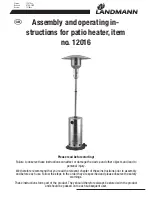
24
ATTENTION:
Whenever a high-pressure double regulation system is utilized for propane gas, consult
a propane expert for accurate pipe and pressure sizing. Make sure that 1st and 2nd stage regulators are
large enough to handle the BTUH input listed for the heater(s) being used.
The manufacturer will not be responsible for heaters that soot up due to improper gas line or propane
tank sizing resulting in improper g
as volume.
WATER PIPING:
The heater is designed f
or use
with pool and spa/hot tub water only, as furnished by municipal water dis-
tribution systems. The warranty does not cover heater use with mineral water, seawater (PPM>5000), or other
non-potable waters.
Do not install any restriction in the water pipe
between the heater outlet and the pool/spa with the
exception of:
1. three-way switching valve
2. in-line chlorinator
3. chlorinator check valve
WARNING
:
EXPLOSION
HAZARD
Blockage of
water fl ow from heater return
to pool may result in fi re or
explosion causing property
damage, personal injury, or
loss of life.
The heater is equipped with CPVC fl anged pipe nipples to accomodate water piping to and from the pool
or spa. These pipe nipples will accept piping by solvent welding (PVC glue). The fi ttings will accept either a 2”
pipe, or a 2 1/2” pipe fi tting, and seal to the heater header with rubber gaskets. On plastic headers, the fi ttings are
secured in place with plastic union nuts, and on bronze headers (ASME models), the fi ttings are secured in place
with bolts. Assemble these parts to the heater prior to plumbing. Tighten union nuts (or bolts) securely before
gluing fi tt
ings to the ends of the pipe nipples. See Figure 11.
The CPVC fl anged pipe nipples must be installed on the heater inlet and outlet without modifi cation. Pipe,
fi ttings, valves, and any other element of the fi lter system may be made of plastic materials, if acceptable to the
authority having jurisdiction.
Heat sinks, heat tapes, fi remen switches, and check valves are not required on the heater. However, if there
is any chance of “back-siphoning” of hot water when the pump stops running, it is suggested that a check valve
be used on the heater inlet pipe.
The built-in bypass inside the header will maintain proper fl ow through the heat exchanger if the fl ow rate is
within the range for the heater. See Table 14. The minimum fl ow rate is to be calculated or measured with the
infl oor cleaning system in use, if the pool is so equipped, as well as any other jets or other demands on the water
fl ow.
Header
Assembly
Gaskets
Union Fittings
Union Nuts
Figure 11: Pipe nipples
















































